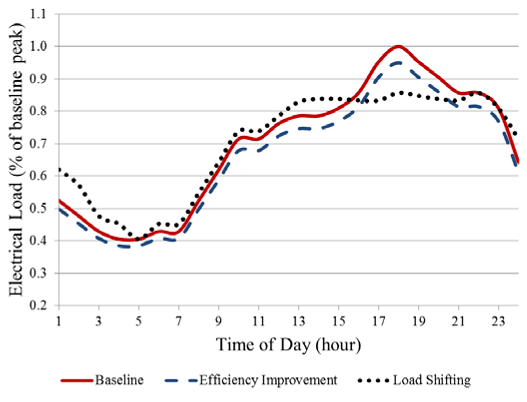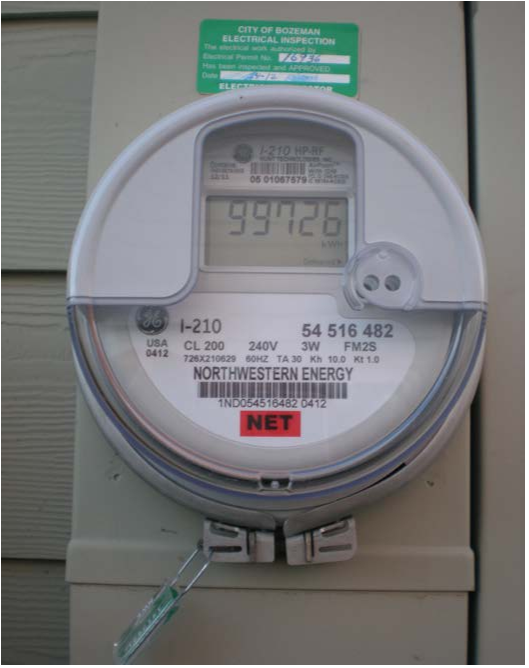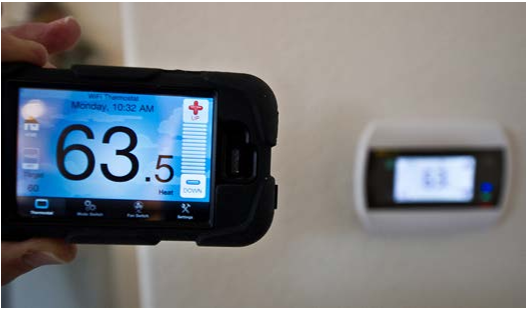
NREL is a national laboratory of the U.S. Department of Energy
Office of Energy Efficiency & Renewable Energy
Operated by the Alliance for Sustainable Energy, LLC
This report is available at no cost from the National Renewable Energy
Laboratory (NREL) at www.nrel.gov/publications.
Contract No. DE-AC36-08GO28308
Electric Energy Management in
the Smart Home: Perspectives
on Enabling Technologies and
Consumer Behavior
Preprint
A
. Zipperer, P. A. Aloise-Young,
S
. Suryanarayanan, and D. Zimmerle
Colorado State University
R
. Roche
University of Technology of Belfort
-Montbeliard
L
. Earle and D. Christensen
National Renewable Energy Laboratory
P
. Bauleo
Fort Collins Utilities
To be p
ublished in Proceedings of the IEEE
Journal Article
NREL/JA-5500-57586
August 2013

NOTICE
The submitted manuscript has been offered by an employee of the Alliance for Sustainable Energy, LLC
(Alliance), a contractor of the US Government under Contract No. DE-AC36-08GO28308. Accordingly, the US
Government and Alliance retain a nonexclusive royalty-free license to publish or reproduce the published form of
this contribution, or allow others to do so, for US Government purposes.
This report was prepared as an account of work sponsored by an agency of the United States government.
Neither the United States government nor any agency thereof, nor any of their employees, makes any warranty,
express or implied, or assumes any legal liability or responsibility for the accuracy, completeness, or usefulness of
any information, apparatus, product, or process disclosed, or represents that its use would not infringe privately
owned rights. Reference herein to any specific commercial product, process, or service by trade name,
trademark, manufacturer, or otherwise does not necessarily constitute or imply its endorsement, recommendation,
or favoring by the United States government or any agency thereof. The views and opinions of authors
expressed herein do not necessarily state or reflect those of the United States government or any agency thereof.
This report is available at no cost from the National Renewable Energy
Laboratory (NREL) at www.nrel.gov/publications.
Available electronically at http://www.osti.gov/bridge
Available for a processing fee to U.S. Department of Energy
and its contractors, in paper, from:
U.S. Department of Energy
Office of Scientific and Technical Information
P.O. Box 62
Oak Ridge, TN 37831-0062
phone: 865.576.8401
fax: 865.576.5728
email: mailto:reports@adonis.osti.gov
Available for sale to the public, in paper, from:
U.S. Department of Commerce
National Technical Information Service
5285 Port Royal Road
Springfield, VA 22161
phone: 800.553.6847
fax: 703.605.6900
email: orders@ntis.fedworld.gov
online ordering: http://www.ntis.gov/help/ordermethods.aspx
Cover Photos: (left to right) photo by Pat Corkery, NREL 16416, photo from SunEdison, NREL 17423, photo by Pat Corkery, NREL
16560, photo by Dennis Schroeder, NREL 17613, photo by Dean Armstrong, NREL 17436, photo by Pat Corkery, NREL 17721.
Printed on paper containing at least 50% wastepaper, including 10% post consumer waste.

1
This report is available at no cost from the
National Renewable Energy Laboratory (NREL)
at www.nrel.gov/publications.
Abstract— Smart homes hold the potential for increasing
energy efficiency, decreasing costs of energy use, decreasing the
carbon footprint by including renewable resources, and trans-
forming the role of the occupant. At the crux of the smart home
is an efficient electric energy management system that is enabled
by emerging technologies in the electricity grid and consumer
electronics. This article presents a discussion of the state-of-the-
art in electricity management in smart homes, the various
enabling technologies that will accelerate this concept, and topics
around consumer behavior with respect to energy usage.
Index Terms—behavioral science, consumer behavior, decision
making, energy management, load management, smart grid,
smart home
I. INTRODUCTION
smart home may be defined as a well-designed structure
with sufficient access to assets, communication, controls,
data, and information technologies for enhancing the occu-
pants’ quality of life through comfort, convenience, reduced
costs, and increased connectivity [1]. The idea has been
widely acknowledged for decades, but few people have ever
seen a smart home, and fewer still have occupied one. A
commonly cited reason for this slow growth has been the
exorbitant cost associated with upgrading existing building
stock to include “smart” technologies such as network
connected appliances [1]. However, consumers have histori-
cally been willing to incur significant costs for new communi-
This work was supported in part by: the U.S. Department of Energy under
Contract No. DE-AC36-08GO28308 with the National Renewable Energy
Laboratory; US National Science Foundation Award # 0931748; and the
Program of Research and Scholarly Excellence (PRSE) grant from the Office
of the Vice President for Research (VPR) at Colorado State University.
A. Zipperer, D. Zimmerle, P. Aloise-Young, and S. Suryanarayanan are
with Colorado State University in Fort Collins, CO, United States (email:
adam.zipperer@rams.colostate.edu).
R. Roche is with IRTES-SET at the University of Technology of Belfort-
Montbéliard in Belfort, France (email: robin.roche@utbm.fr).
L. Earle and D. Christensen are with the National Renewable Energy
Laboratory in Golden, CO, United States (email: dane.christensen@nrel.gov).
P. Bauleo is with Fort Collins Utilities in Fort Collins, CO, United States
(email: pbauleo@fcgov.com).
cation technologies, such as cellular telephones, broadband
internet connections, and television services. Table I presents
the changes in US mean monthly income by quintiles and
overall consumer spending on communication services,
adjusted for 2011 USD [2]–[6].
TABLE I. US MONTHLY INCOME AND COMMUNICATIONS
EXPENDITURES FOR 1980 AND 2008
This information may indicate that consumers are not
averse to significantly changing their spending habits with the
advent of new technologies. According to the US Bureau of
Labor Statistics the average homeowner spent approximately
11% more on entertainment (including cell phone and internet
services) in 2010 than 25 years ago [2]. Data indicate that
consumers are willing to spend more on hybrid vehicles than
on similarly sized traditional vehicles for reasons other than
economic payback [7].
Diverse motivations can lead to the same end goal. For
instance, a consumer may purchase a hybrid vehicle to
decrease carbon emissions, reduce dependency on foreign oil,
save money, or simply as a status symbol. Regardless, driving
a hybrid vehicle contributes to a more sustainable energy
future by reducing oil consumption and greenhouse gas
emissions. Similarly, marketing or societal influences may
motivate consumers to invest in smart home technologies.
The authors contend that cost and the lack of perceived
value have combined to slow the adoption of smart homes.
However, the perceived value of a smart home is likely to
vary across populations [8].
Electric Energy Management in the Smart
Home: Perspectives on Enabling Technologies
and Consumer Behavior
Adam Zipperer, Student Member, IEEE, Patricia A. Aloise-Young, Siddharth Suryanarayanan, Senior
Member, IEEE, Robin Roche, Member, IEEE, Lieko Earle, Member, IEEE, Dane Christensen,
Member, IEEE, Pablo Bauleo, Daniel Zimmerle, Member, IEEE
A
1980 ($) 2008 ($) Change (%)
Mean Income Quintile I 4,310 11,656 170
Mean Income Quintile II 10,727 29,517 175
Mean Income Quintile III 17,701 50,132 183
Mean Income Quintile IV 26,078 79,760 206
Mean Income Quintile V 46,497 171,057 268
Communication Services 22 117 432

2
This report is available at no cost from the
National Renewable Energy Laboratory (NREL)
at www.nrel.gov/publications.
The US Energy Information Administration (EIA) estimates
that 37% of end use electricity in the US is consumed in
residences [4]. Concomitantly, household appliances,
consumer electronics, and construction techniques are
becoming increasingly efficient [5]. As the Smart Grid
Initiative in the US progresses, the end-user is enabled with
near-real time information from the service provider [9]. This
presents an opportunity to coordinate the management of
appliances and other loads in the smart home, considering
information flow and end-user behavior.
This paper is organized as follows: section II describes a
smart home; section III outlines the assets and control
strategies in a smart home; section IV presents some enabling
technologies; section V explains consumer energy behavior,
especially in a residential environment; and, section VI offers
concluding remarks.
II. S
MART HOMES
A. What is a Smart Home?
A home is already a well-designed connector for power
transfer between the electricity grid and energy-consuming
appliances. A smart home also functions as a switchboard for
data flow among appliances and participants such as the end-
user, the electric utility, and a third party aggregator [9], [10].
This evolved capability benefits stakeholders on both sides of
the interface – utility customers, utilities, and third party
energy management firms – because there are strong incen-
tives for all sides to help the others function smoothly. For
instance, a homeowner may not inherently care about the peak
demand issues faced by the utility, but electricity prices and
supply reliability are tied to operational practices of the
service provider. On the other hand, a utility may be primarily
concerned with meeting the requirements of public utility
commissions, but unhappy ratepayers may result in business
and regulatory risks.
Looking outward, a smart residential building has two-way
communication with the utility grid, enabled by a smart meter,
shown in Fig. 1, so that it can interact dynamically with the
grid system, receiving signals from the service provider and
responding with information on usage and diagnostics. A
detailed description of the smart meter is provided in section
IV. This bidirectional information exchange is enabled by the
rapid adoption of advanced metering infrastructure (AMI).
Fig. 1. A smart meter at a residence. Photo sourced from National Renewable
Energy Laboratory (NREL) database, PIX 21394.
Looking inward, a smart home employs automated home
energy management (AHEM), an elegant network that self
manages end-use systems based on information flowing from
the occupants and the smart meter. The value of AHEM is in
reconciliation of the energy use of connected systems in a
house with the occupant’s objectives of comfort and cost as
well as the information received from the service provider.
Sensors and controls work together via a wireless home area
network (HAN) to gather relevant data [11], process the
information using effective algorithms, and implement control
strategies that simultaneously co-optimize several objectives:
comfort and convenience at minimal cost to the occupant,
efficiency in energy consumption, and timely response to the
request of the service provider [12]. An example of a smart
home, constructed in a laboratory setting at NREL, is shown
in Fig. 2.

3
This report is available at no cost from the
National Renewable Energy Laboratory (NREL)
at www.nrel.gov/publications.
Fig. 2. NREL’s AHEM laboratory. Photo sourced from NREL database, PIX
20207.
B. Economic feasibility and likelihood of widespread
adoption
Several market and technology trends are expected to
accelerate the development of cost-effective AHEM systems
that enable smart homes. These include:
• Implementation of smart grids and continued growth in
home offices will expand market penetration of secure
HANs.
• Growth in web-based cloud computing applications will
enable low-cost home energy data storage, data display,
and data analysis for AHEM trend analysis [13].
• Advancements in smartphone technology such as batter-
ies, user interfaces, and material [14], are expected to aid
the development and adoption of AHEM systems.
• Manufacturers of residential equipment and appliances
continue to embed additional sensors and control capabil-
ities in new, smart home appliances that are internet-
ready, can respond to requests from service providers,
and offer advanced cycle controls such as multi-mode or
variable speed controls and fault diagnostic sensors for
space-conditioning equipment and "eco" modes for
dishwashers, clothes washers, and other major appliances
[15].
• Integration of energy services into other networked
product offerings, such as security systems and television
and telephony service.
A key strategy to engaging all stakeholders may lie in
changes to the end-user electricity pricing structures – from
fixed tariffs to dynamic prices that may change several times
over a day – that reflect the use of the assets on the grid at any
given time. If these structures are implemented to provide a
tangible financial incentive for customers to respond to the
requests of the service providers for demand reduction, the
customers can receive measurable monetary value for their
participation, in addition to the increased reliability of their
service. Financial incentives are but one motivating factor for
the adoption of smart homes.
C. Smart Home Energy Management
Large-scale demonstration efforts have thus far approached
smart home research with a strong utility focus and less
homeowner focus. Currently the incentive for homeowner
participation is limited to relatively small financial gain via
utility pricing structures; otherwise the motivation is primarily
altruistic (i.e., environmental benefits). Most utilities offer
incentives for energy upgrades such as attic insulation or
ENERGY STAR
®
appliances and many have leveraged load-
shedding technologies that cycle air conditioners during peak
load events. Increasingly, utilities are funding more elegant
efforts for on-request load reduction in the residential sector.
For example, CPS Energy of San Antonio, Texas has
partnered with Consert Inc. to demonstrate a load reduction
system that can alter air conditioner and water heater set
points and pool pump operation at the end-user facility during
peak load times to enable substantial peak savings with
limited impact on their customers [16]. This system is being
rolled out to most residential customers in the San Antonio
service territory.
Some utilities such as ComEd provide near-real time data to
homeowners, along with several pricing structures and load
reduction requests [17]. Many companies have recently
incorporated web-based user interfaces, so a homeowner can
adjust thermostat settings or turn off lights from a smartphone,
as shown in Fig. 3 , or a web browser [15].
Fig. 3. A smartphone app for smart homes. Photo sourced from NREL
database, PIX 20284.
Advanced grid measurements using AMI infrastructure are
being rolled out in California and Texas [18]. These projects
have multipronged focus of better integration of renewables,
enhancement of efficiency, and optimization of consumer
demands with utility needs on a community scale. Emerging
nonintrusive load measurement systems can provide enabling
data, but these modern measurement techniques are not yet
robust, accurate, easy to install, or cost-effective for integra-
tion at the meter [19]. The available legacy methods for load
disaggregation use algorithms supplemented with estimation,
so the results may have less relevance to a given household
than across an aggregated population [ ].
![Fig. 4. Schematic diagram of a centrally controlled smart home adapted from [31]](/figures/fig-4-schematic-diagram-of-a-centrally-controlled-smart-home-2w5c6g9l.png)




